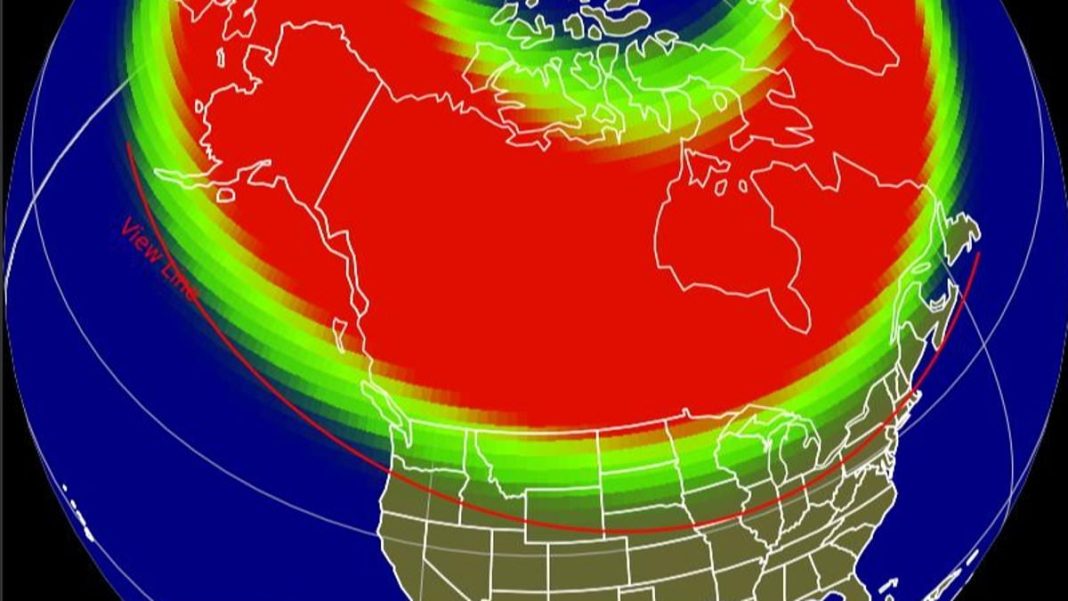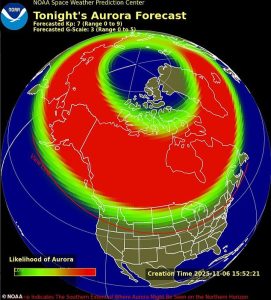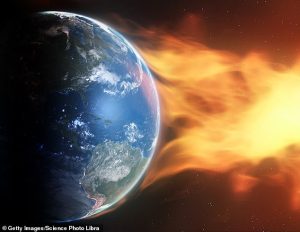Key Takeaways
- A strong G3 geomagnetic storm is affecting Earth, threatening power grids and satellite systems
- Northern US states may experience auroras and potential infrastructure disruptions
- The storm originated from solar eruptions on November 5 and effects may continue through Friday
A powerful solar storm is currently striking Earth, disrupting our planet’s magnetic field and posing significant risks to power grids, satellites, and GPS systems across the United States. The G3-level geomagnetic event began late Wednesday and is expected to persist throughout Thursday, according to NOAA forecasters.
Storm Intensity and Timeline
The solar storm reached its peak intensity between 1:27 AM and 2:00 AM ET Thursday morning but continues at G2 strength into the afternoon. This event results from multiple coronal mass ejections (CMEs) – massive eruptions of solar plasma – with four detected since November 3. The latest plasma burst occurred on November 5, with effects projected to continue through Friday.
A G3-level storm, classified as ‘strong,’ can cause:
- Voltage fluctuations and potential power grid damage
- Satellite malfunctions and GPS disruptions
- Radio blackouts and communication issues
While the most severe impacts typically occur near polar regions, this storm’s effects could extend as far south as Pennsylvania, Iowa, and Oregon.
Aurora Viewing Opportunities
Several northern states including New York, Vermont, New Hampshire, Maine, Michigan, Wisconsin, Minnesota, Montana, Idaho, Washington and the Dakotas were positioned to witness auroras during the storm’s peak. NOAA forecasts indicate the Northern Lights may still be visible Thursday night in dark, high-elevation areas.
‘Aurora may be seen as low as New York to Wisconsin to Washington state,’ NOAA’s latest forecast revealed
For optimal viewing, experts recommend finding dark locations away from city lights, facing north, and using space weather apps for real-time updates.
Understanding Geomagnetic Storms
Geomagnetic storms occur when solar plasma eruptions temporarily disrupt Earth’s magnetic field. These events are rated on a scale from G1 (minor) to G5 (extreme), with G3-level activity typically lasting several hours. NOAA warns that disturbances could continue into Thursday evening in some regions, with weaker after-effects persisting up to 12 hours.
Since NOAA’s initial warning, the agency has issued two additional alerts as storm strength fluctuated between G3 and G1 levels before stabilizing at G2 strength Thursday morning. The strongest impacts are currently expected in Canada, Alaska, and northern Europe.
Preparedness and Long-Term Concerns
Power companies typically monitor solar forecasts and adjust grid settings to prevent problems. Experts recommend that residents in high-latitude areas or those relying on sensitive electronics keep flashlights and backup power sources available in case of stronger-than-expected solar events.
Scientists warn that communication disruptions from solar activity may worsen in coming years due to a growing ‘weak spot’ in Earth’s magnetic field known as the South Atlantic Anomaly (SAA). This region spans over 4.3 million square miles across parts of Africa and South America and continues to expand westward.
The magnetic weakness allows harmful solar radiation particles to penetrate closer to Earth’s surface. NASA scientists note this radiation ‘can knock out onboard computers and interfere with the data collection of satellites that pass through it.’







